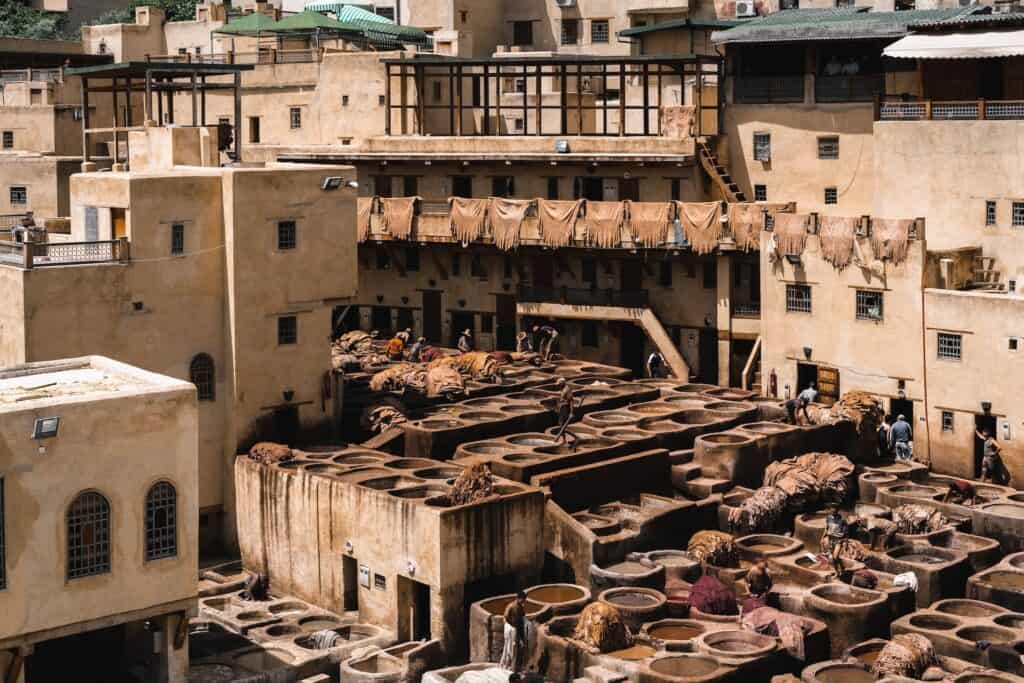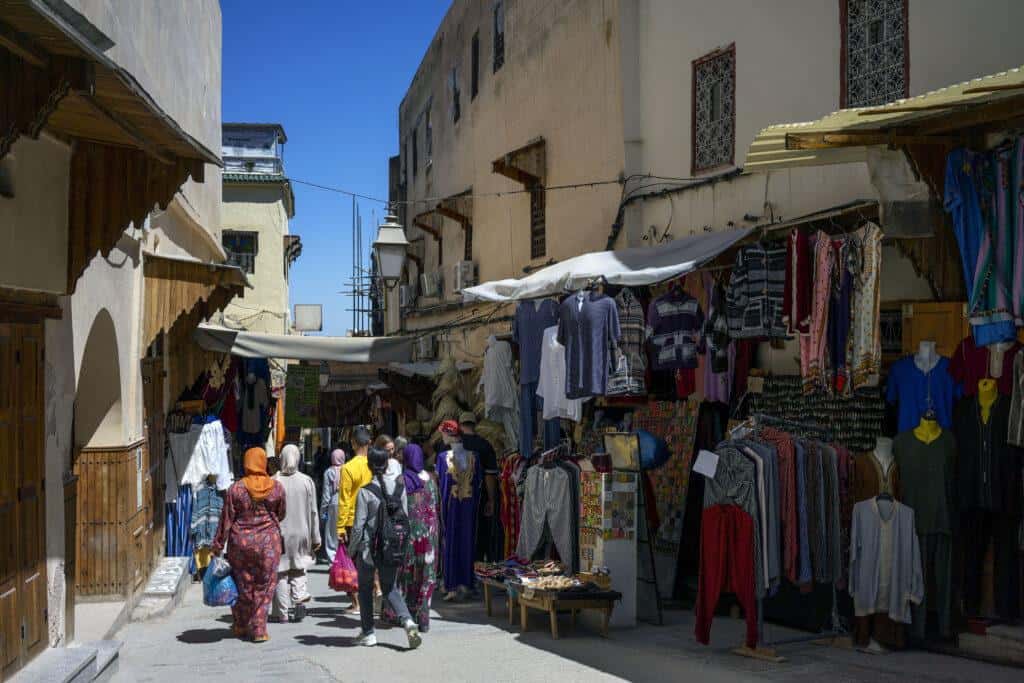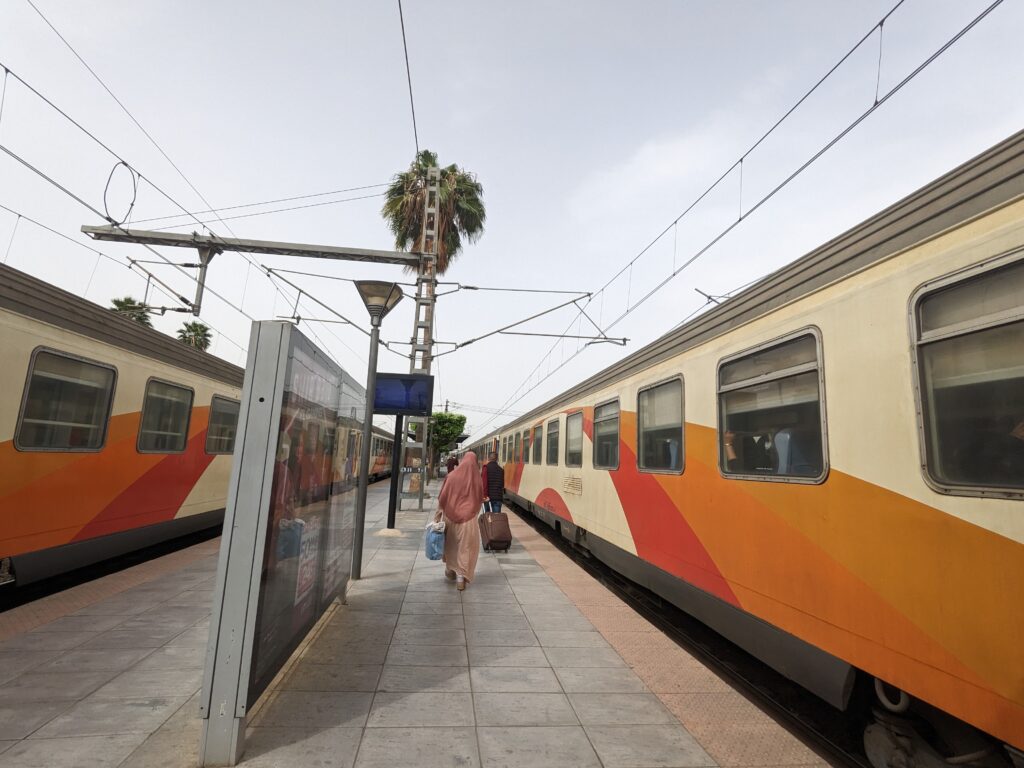Last Updated on December 14, 2023
Knowing what not to do in Morocco will set you up for smooth and memorable travels around this beautiful North African country.
The Kingdom of Morocco is part of the group of North African countries known as the Maghreb.
It has Atlantic and Mediterranean coastlines, an interior of mountains and deserts, and a history of independence (that Morocco’s neighbors haven’t had).
Morocco is very diverse, blending Arab, Berber, European and African culture.
If you’re headed to Morocco, read on to find out what not to do in Morocco. You’ll learn must-know Morocco travel tips, including the Moroccan customs visitors should know, and why you should book to stay in a riad.
Disclosure: This article includes affiliate links. This means that if you make a purchase through one of those links, I earn a small commission. Affiliate links cost you nothing to use, and keep Pina Travels reader-supported. Thank you!
- What Not to Do in Morocco: 20 Important Travel Tips!
- 1. Don’t Carry Large Bills
- 2. Don’t Barter for Unfair Prices
- 3. Don’t Book a Hotel (Book a Riad Instead!)
- 4. Don’t Drink Tap Water in Morocco
- 5. Don’t Overplan Your Days
- 6. Don’t Accept Unsolicited Help or Directions
- 7. Don’t Be Afraid to Speak Up
- 8. Don’t Engage in Animal Tourism
- 9. Don’t Forget to Learn About Local Customs
- 10. Don’t Get Into Taxis Without Agreeing on Price
- 11. Don’t Take Photos Without Permission
- 12. Don’t Forget to Download an Offline Map App
- 13. Don’t Forget to See Morocco Beyond Marrakech
- 14. Don’t Skip Moroccan Train Travel
- 15. Don’t Forget That Friday is a Holy Day
- 16. Don’t Try to Enter Mosques
- 17. Don’t Forget To Check Entry Requirements
- 18. Don’t Expect To Party
- 19. Don’t Skip the Rooftop Terraces
- 20. Don’t Forget Your Travel Insurance
- Final Thoughts: What Not to Do in Morocco
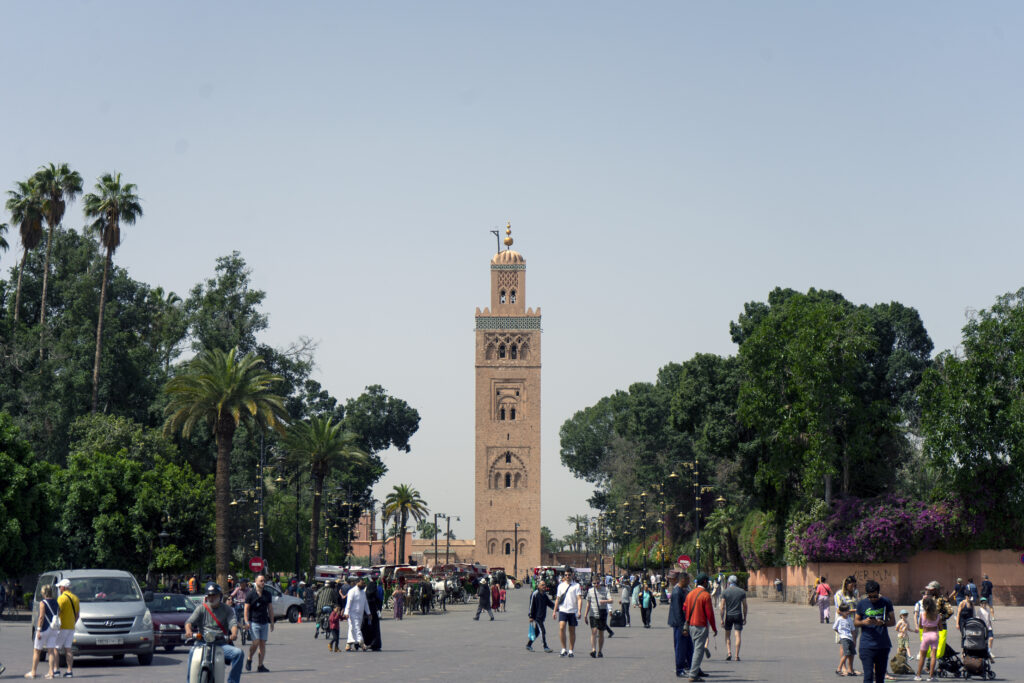
What Not to Do in Morocco: 20 Important Travel Tips!
1. Don’t Carry Large Bills
Morocco’s currency is the Moroccan dirham (MAD). Dirhams come in various denominations. You will find 20, 50, 100 and 200 dirham notes in circulation, as well as coins in smaller denominations.
While traveling Morocco you’ll find yourself wanting to buy little things here and there. Maybe some street food or a drink, or something to take home from the souks. You’ll also need to pay for meals, taxis, and hotels, and more.
While credit cards are increasingly being accepted, particularly in Moroccan cities, many vendors, shops, hotels, and most taxis, will only accept cash.
It’s best to carry small bills while in Morocco. This makes paying simpler because the vendor won’t need to find change for you.
2. Don’t Barter for Unfair Prices
It’s okay to be budget conscious while traveling Morocco, as long as you don’t go overboard with your budgeting practices, and you follow best practices for responsible budget travel.
In Morocco, bartering prices is a common practice. What’s also common is the “tourist tax.” This is a colloquial term for when locals in a place charge higher prices when foreigners buy their goods versus other locals.
Some travelers are upset by the tourist tax. But I think that it’s fair that locals maximize their income by setting prices based on what a buyer can afford.
If a person has the means to travel, and is benefiting off of the strength of their home currency, paying a slightly higher price is reasonable.
If you can afford to travel, then you can afford to pay prices that are fair. And yes, that fair price may be more than what a local would pay.
In practice, it is good to barter in Morocco, but do so in a respectful and fair way. I recommend asking the initial price, and then barter down just once or twice from there.

3. Don’t Book a Hotel (Book a Riad Instead!)
What not to do in Morocco? Don’t book only hotels. Instead, book riads for your stay. These will be available mostly in cities.
A riad is a traditional house or palace that typically has an interior open-air courtyard and garden. They’re usually multiple floors, and have multiple rooms.
The riads in Marrakech, for example, have stunning architecture and design. While some riads have been modernized, others are more traditional in their decor.
What’s most amazing about riads is how quiet they are. When you step into a riad off the busy streets of a medina, you’ll notice it’s suddenly calm and quiet, a nice respite from the bustling city.
In the past, riads were the estates of Morocco’s wealthiest citizens, merchants, and courtiers.
Today, many of the riads in Moroccan cities have been converted to hotels. A visit to Morocco is not complete without a stay in one of these beautiful buildings!
On my most recent trip to Marrakech, I stayed in Riad Laila. This riad is a 15 minute walk away from Jemaa El Fna Square in Marrakech. It’s in a quiet part of the city which is a nice respite from how busy the medina can be!
What I especially loved about Riad Laila was the friendly and helpful staff, and their beautiful garden area.
In the garden there is a pool where you can cool off, and they also have a rooftop with comfy chairs and lounging areas.
Our room was very quaint, and a delicious breakfast spread is included every morning. You can book Riad Laila, here!
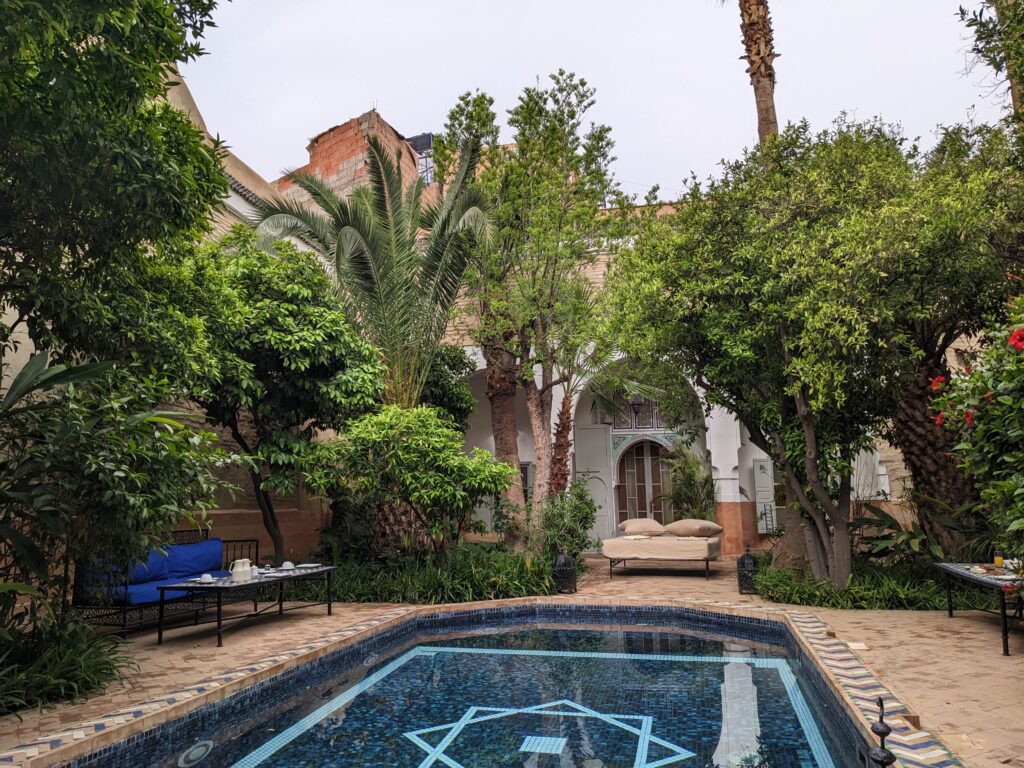
4. Don’t Drink Tap Water in Morocco
It’s probably best to drink filtered or bottled water while traveling in Morocco.
While most locals do drink tap water, it may not be worth the risk for visitors. You don’t want to end up with a stomach bug that impacts your trip.
When eating at food stalls and restaurants, it’s best to buy bottled water, or bring your own filtered water. One solution is to bring a filtering water bottle with you to Morocco.
Filtering your own water is a sustainable tourism practice because it will reduce how much plastic waste you generate.
There are various systems to choose from that suit different needs, but all systems have the same function: they filter contaminants out of water, making it safe to drink.
There are tons of options to choose from, Lifestraw is a popular one, but I personally love my Grayl bottle.
5. Don’t Overplan Your Days
What not to do in Morocco? Don’t overplan! It’s easy to plan your days in Morocco to be busy with activities, but this doesn’t leave much time for wandering.
The old medinas in Marrakech, Fes, Essaouira, and other Moroccan cities are amazing to walk around without much of a plan. These old historic centers date back as far as the 11th century.
Inside the medinas you’ll typically find busy, narrow streets, shops, food stalls, and more.
Wandering is the best way to truly get a feel for these old cities. Take the time to slowly walk around. You’ll stumble on quiet neighborhoods, beautiful alleys, and little shops.

6. Don’t Accept Unsolicited Help or Directions
It’s common to be offered unsolicited help in some parts of Morocco – particularly in cities.
A local will approach you, and tell you they can guide you to your riad, to a landmark, or wherever else you’re going.
When they first approach, they won’t mention being paid for this help, but once they’ve brought you to your destination, they’ll ask for an overinflated tip. Usually, they won’t leave until you’ve paid them.
In situations where you actually need the help, this isn’t a bad service to pay for. But, it’s better that you ask a police officer, or someone inside a shop, who isn’t motivated by money.
This is because you have no idea how much you will be asked to pay in exchange for the service if you go with someone who approaches you.
7. Don’t Be Afraid to Speak Up
You will likely find yourself being approached often by locals in Morocco, particularly in the cities that are popular for tourism.
They may want to offer you guidance, like I mentioned in the previous point. They’ll maybe want to take you to your shop, or sell you something right there on the spot.
In some cases, you might find yourself becoming irritated by this, especially if it happens to you often.
Don’t be afraid to speak up and firmly say no when approached. Often, this point blank statement will send the salesperson right on their way.
It might seem harmless and fun to pose for a photo with one of these animals, or to give money to their handlers to watch a monkey perform tricks.

8. Don’t Engage in Animal Tourism
While in Morocco, you’re likely to encounter animals like camels, monkeys, and even snakes.
For example, in Marrakech’s Jemaa el Fna Square, you’ll notice monkey handlers and snake charmers. For a fee, they will invite you to interact with the animals, and take photos with them.
But it’s actually a link in the chain of the illegal trade which is threatening Barbary macaque populations in the wild. These monkeys are caught when they are young and trained to perform.
It can be very hard to figure out which wildlife tourism experiences are responsible.
Your safest bet is to avoid any animal tourism experiences that involve touching or feeding an animal, or posing for a photo with an animal.
While in Morocco, don’t engage with the monkey handlers or snake charmers.
If more and more people don’t engage, the demand for this kind of entertainment will drop, and it will be a less common form of tourism offering in the city.
9. Don’t Forget to Learn About Local Customs
Depending on where you’re traveling to Morocco from, you might find that the culture and traditions are different from what you’re used to at home.
Take the time to learn about Moroccan customs and traditions, and then be respectful of them. For example, in Morocco, people traditionally dress modestly.
When visiting Morocco, women travelers can show cultural respect by wearing long, loose-fitting clothing that covers the upper arms, knees, chest, midriff and back.
Men can show respect by covering their shoulders and their legs.
Another important custom in Morocco is dining etiquette. When you eat in local restaurants, or are invited into a local’s home for a traditional Moroccan meal, you might notice that dishes are eaten with your hands instead of using cutlery. It’s also customary to eat only with the right hand.

10. Don’t Get Into Taxis Without Agreeing on Price
There are two types of taxis in Morocco. “Petite” taxis and “grand” taxis. Petite taxis seat three people, and they charge you based on a metered price. A petite taxi can take you to specific locations within city limits.
Grand taxis can hold up to 8 people, and you pay a specific rate for your seat.
These taxis don’t begin their trip until they are filled, or until people pay for the seats that are remaining. Grand taxis usually go to destinations further out, like to neighboring villages.
Tourists will mainly use petite taxis. Whenever you get into a petite taxi you need to ask for the meter (you can use the French word, “compteur”).
In some Moroccan cities, taxi drivers might tell you that their meter is broken. In this case, decide on a price before the trip begins. The taxi driver will likely start with a high price. Barter a little bit before landing on an agreed price.
11. Don’t Take Photos Without Permission
An important thing not to do in Morocco has to do with taking photos. As with traveling anywhere, it’s important to be intentional and respectful when taking pictures.
In Morocco, some people will refuse being photographed for religious reasons. Given this, if you would like to take a photo of a person, be sure to ask for their consent.
If you plan to share a photo of a person to your social media, or any online platform, it’s important to have explicit consent to do so.
When taking photos of the countryside, beaches, streets, or alleys around Morocco, be aware of who might end up in the frame of the photo. Wait a moment until local people are out of the frame before snapping the image.
It’s also important to think about what a photo depicts. Sharing images of poverty, or less developed communities for self-gratification is an unfortunate symptom of the White Saviour Industrial Complex.

12. Don’t Forget to Download an Offline Map App
In the old medinas of Moroccan cities, the streets are often very narrow. In some cities, only pedestrians, motorbikes, and bicycles can access the historic medinas.
It’s easy to get lost in the medinas of Fes, Marrakech, and other cities. These medinas are made up of winding alleyways that intersect, and aren’t always well marked.
An offline map app will ensure you don’t get lost! While offline isn’t absolutely necessary, I recommend downloading maps to use offline *just in case* you run out of mobile data, or lose connectivity.
I usually use Google Maps for my offline maps. To download offline maps of cities and towns in Morocco, go into your settings, tap “Offline Maps,” and select a region to download.
13. Don’t Forget to See Morocco Beyond Marrakech
What not to do in Morocco? Don’t just see Marrakech! While Marrakech is a beautiful and exciting city, there’s much more to Morocco.
Beyond the bustling city of Marrakech there are deserts, mountain villages, seaside towns, and more.
Traveling beyond Marrakech will give you more insight into life in Morocco, help to reduce the impact of overtourism, and help give you a well-rounded experience.
Head to the coastal city of Essaouira to experience its medina, which has been painted white and is surrounded by a fortress wall. See the city’s old Portuguese fortress, fishing port, and head to the sandy beaches to watch surfers.
Or, go to the northern city of Fes. It’s medina is the world’s largest surviving medieval city, and urban car-free zone.
And of course, you can travel down to the Sahara Desert. There, you can learn about Berber culture while experiencing desert life.

14. Don’t Skip Moroccan Train Travel
Trains in Morocco are operated by ONCF (Office National des Chemins de Fer du Maroc). They are reasonably priced, fast, and a comfortable way to travel around the country.
Traveling by train in Morocco is also a great way to see some of the landscapes between cities. While there isn’t an extensive network of ONCF trains, they do connect the country’s biggest cities.
15. Don’t Forget That Friday is a Holy Day
Fridays are a sacred day in Morocco. There are prayers, and families and friends gather, stay at home, and share a meal together.
Because of this, cafes, stores, and restaurants may not open on Friday until the late afternoon, when prayers have finished.
In smaller towns and cities you’ll notice the Friday closures more than in bigger cities, where some Moroccans may open their shops on Friday morning for tourists.
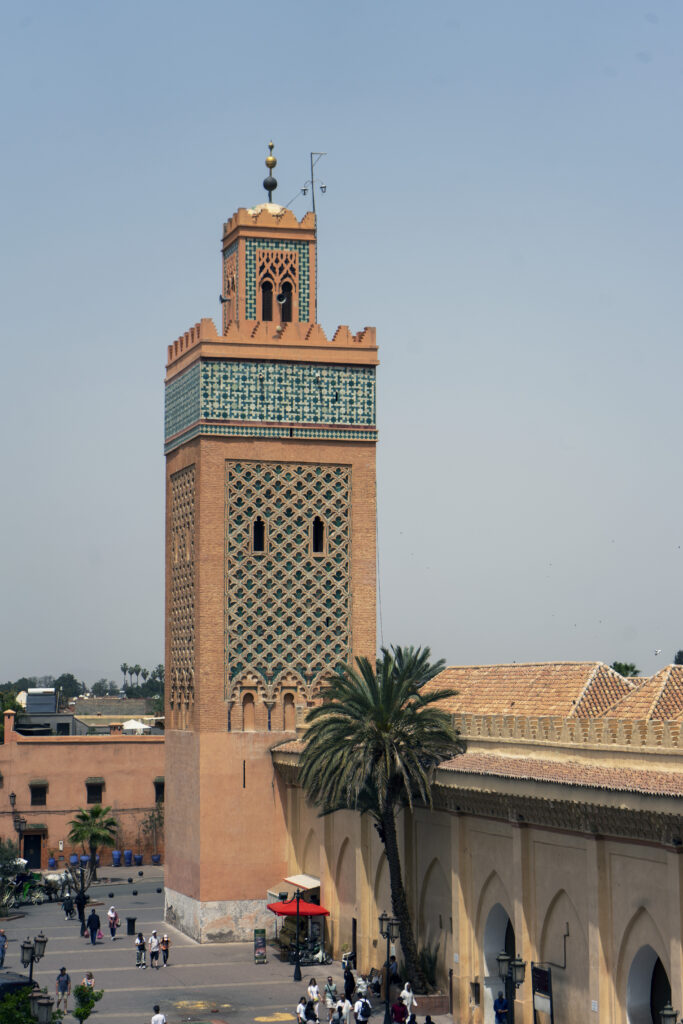
16. Don’t Try to Enter Mosques
Not every mosque can be visited by tourists in Morocco, unless they are Muslim and they come to the mosque to pray.
You’ll need to check in advance if you’ll be permitted to enter a mosque you’d like to visit. One mosque that allows non-Muslim tourists to visit is the famous Hassan II mosque in Casablanca.
Although you won’t be able to go inside most mosques, it’s still worth it to go to at least one mosque, and walk around the grounds.
For example, Koutoubia in Marrakech is beautiful to admire, and it’s nice to walk around the gardens that surround it.
17. Don’t Forget To Check Entry Requirements
Before entering Morocco, check the entry requirements for your nationality. Citizens of around 65 countries do not need a visa to enter Morocco for up to 90 days. Those visitors can get their visa on arrival at their entry point.
Other nationalities need to have a visa or travel authorization to be eligible for visiting Morocco.
People from over 100 countries are eligible to apply for the Moroccan e-Visa, which is an electronic visa that can be easily applied for online.

18. Don’t Expect To Party
Morocco isn’t really a place to travel to for nightlife and partying.
Although alcohol is permitted in some settings, and some Moroccan cities do have nightclubs and bars, drinking culture in Morocco is different than what people from North America or Europe are used to.
Drinking and partying tends to happen behind closed doors in Morocco. In fact, drinking in public in Morocco is prohibited.
It is not culturally acceptable to drink in public, or to be visibly drunk in public, and so it’s best to respect this while visiting.
Most Moroccan cities will have a few liquor stores, so it is possible to buy something to enjoy in the privacy of your hotel room.
You will find that in cities like Marrakech and Casablanca, where there are bars, the drinks are quite expensive.
19. Don’t Skip the Rooftop Terraces
In the old medinas of Moroccan cities, the streets between buildings are typically very narrow.
As a result, many of the buildings have rooftop terraces. These terraces are where local people will hang laundry to dry, or gather to socialize.
In cities like Marrakech, Tangier, Fes, and Chefchaouen, you’ll find that many riads and restaurants have a rooftop terrace.
Take advantage of them! From these rooftops you’ll gain a new perspective of the medinas. They’re also the perfect spot to catch a beautiful sunset view.
For example, in the Fes medina, head to Café Terrasse Panoramique. I enjoyed mint tea on this rooftop every afternoon that I was in Fes.

20. Don’t Forget Your Travel Insurance
What not to do in Morocco? Visit without travel insurance! Travel insurance is essential to pack for every single trip.
Insurance coverage provides support, compensation, and medical care when things go wrong while you’re abroad.
Policies for travel insurance vary, but they can provide support and compensation if your luggage is lost, if you slip and break a bone, or if you need to return home because of an emergency in the family.
Travel insurance is an important financial safety net for your valuables and for emergencies, so don’t forget it when you go to Morocco.
Final Thoughts: What Not to Do in Morocco
I hope these tips for what not to do in Morocco help you plan a worry-free, memorable trip to this beautiful country. I wanted to share these because I truly believe that being an informed tourist is the best way to be a responsible tourist!
More on Morocco from Pina Travels:
- Fes or Marrakech: Which Should You Visit?
- What Not to Do in Marrakech
- Sleeping in the Sahara Desert, Morocco
- 4 Days in Fes: A Comprehensive Itinerary
Erin has been traveling for over a decade, both solo, and with her partner. She’s now traveled to countries across 6 continents, and has lived in 2 countries abroad. Erin also hosts the travel podcast, Curious Tourism, where she interviews travel industry thought leaders and experts about responsible tourism. Learn more about Erin, and get in touch with her, here.

